Lesson 40 Move Your Body 教学设计
文档属性
| 名称 | Lesson 40 Move Your Body 教学设计 | 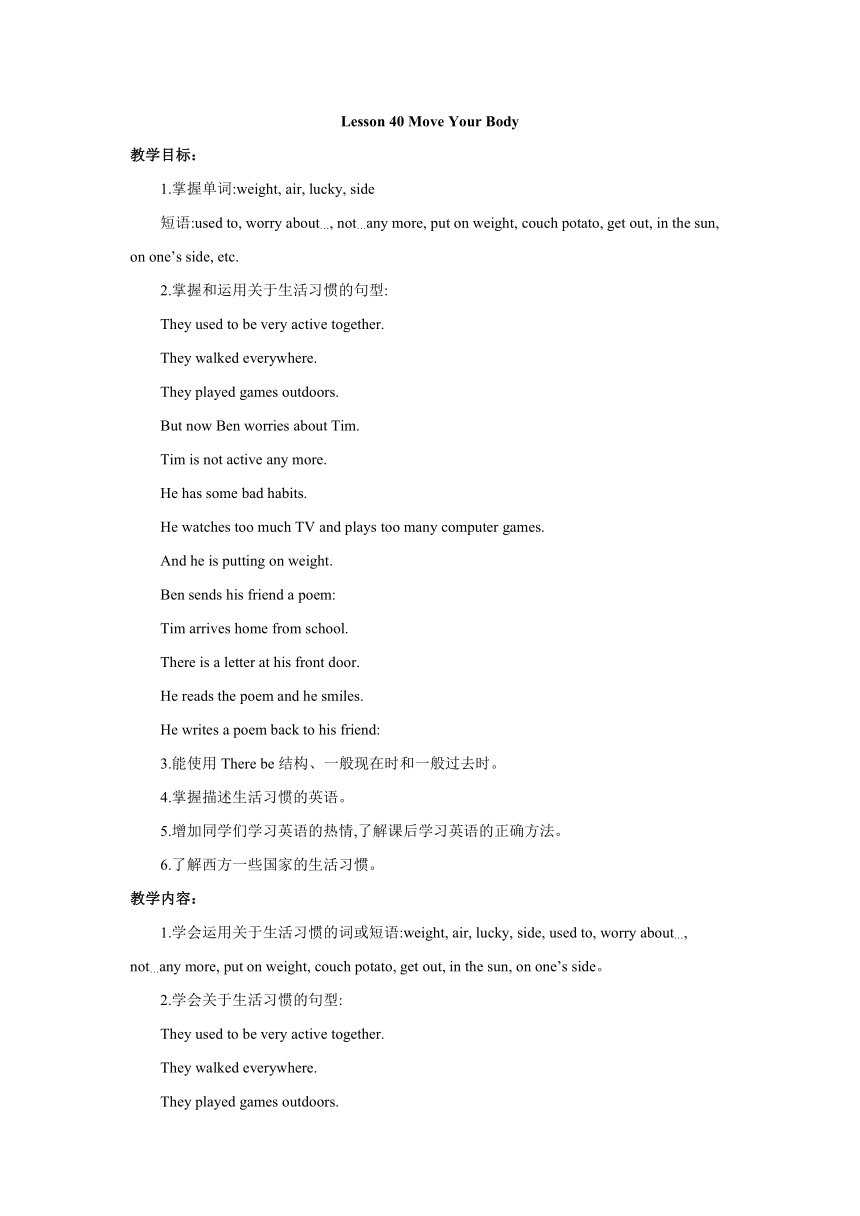 | |
| 格式 | zip | ||
| 文件大小 | 28.5KB | ||
| 资源类型 | 教案 | ||
| 版本资源 | 冀教版 | ||
| 科目 | 英语 | ||
| 更新时间 | 2019-06-27 17:03:49 | ||
图片预览

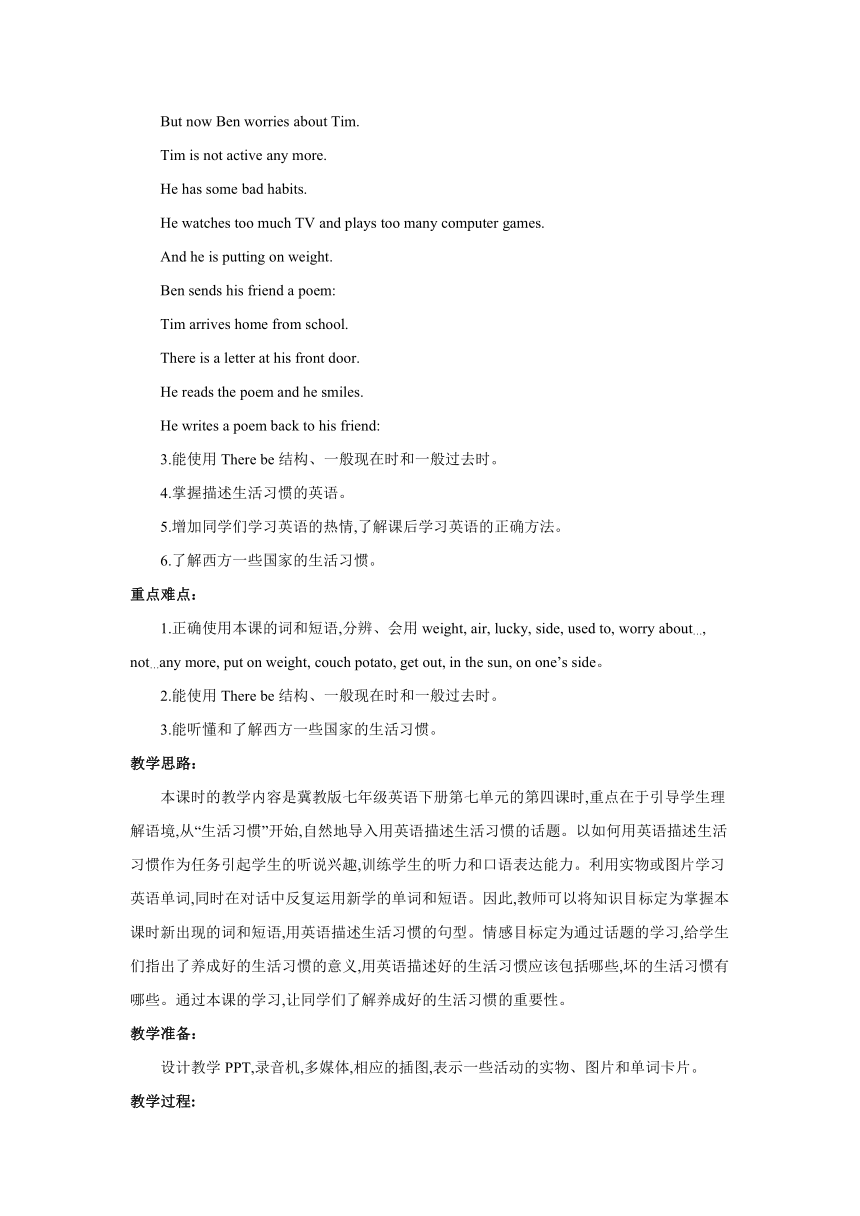
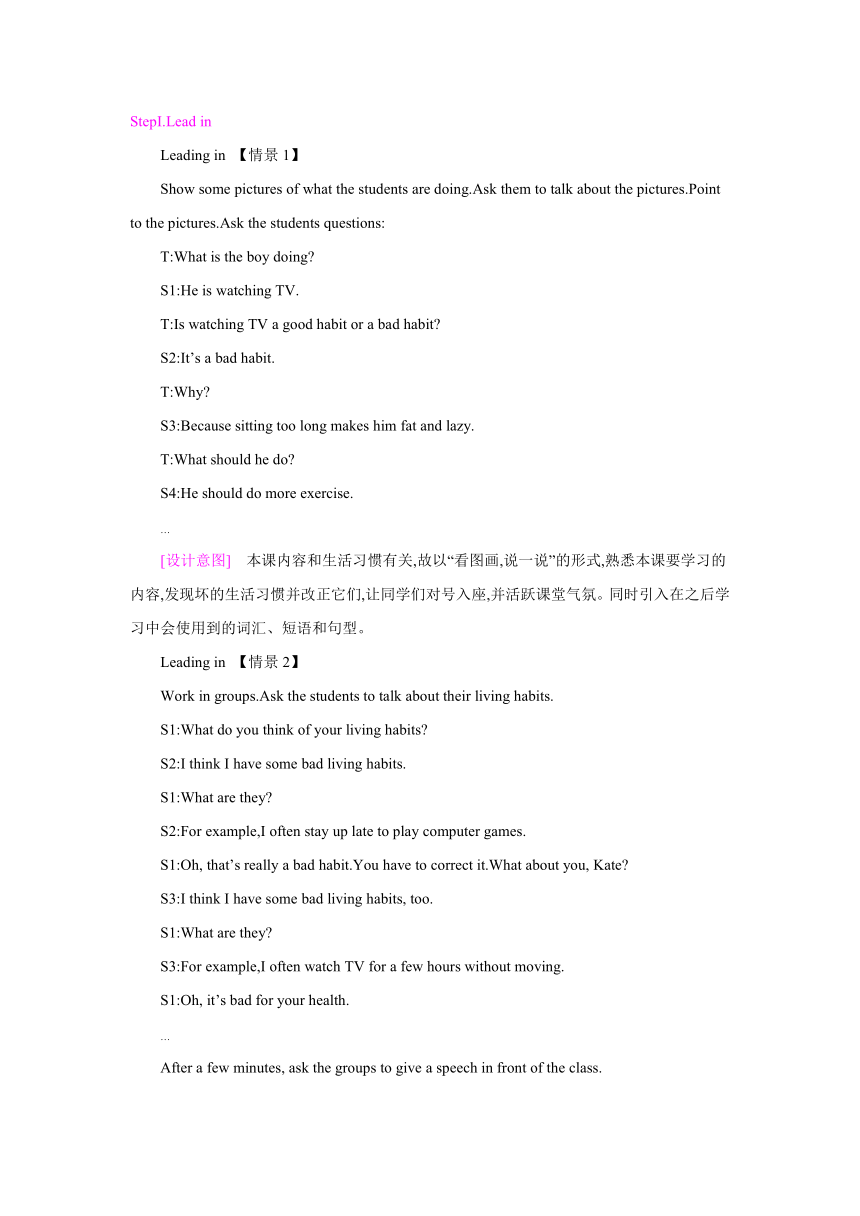
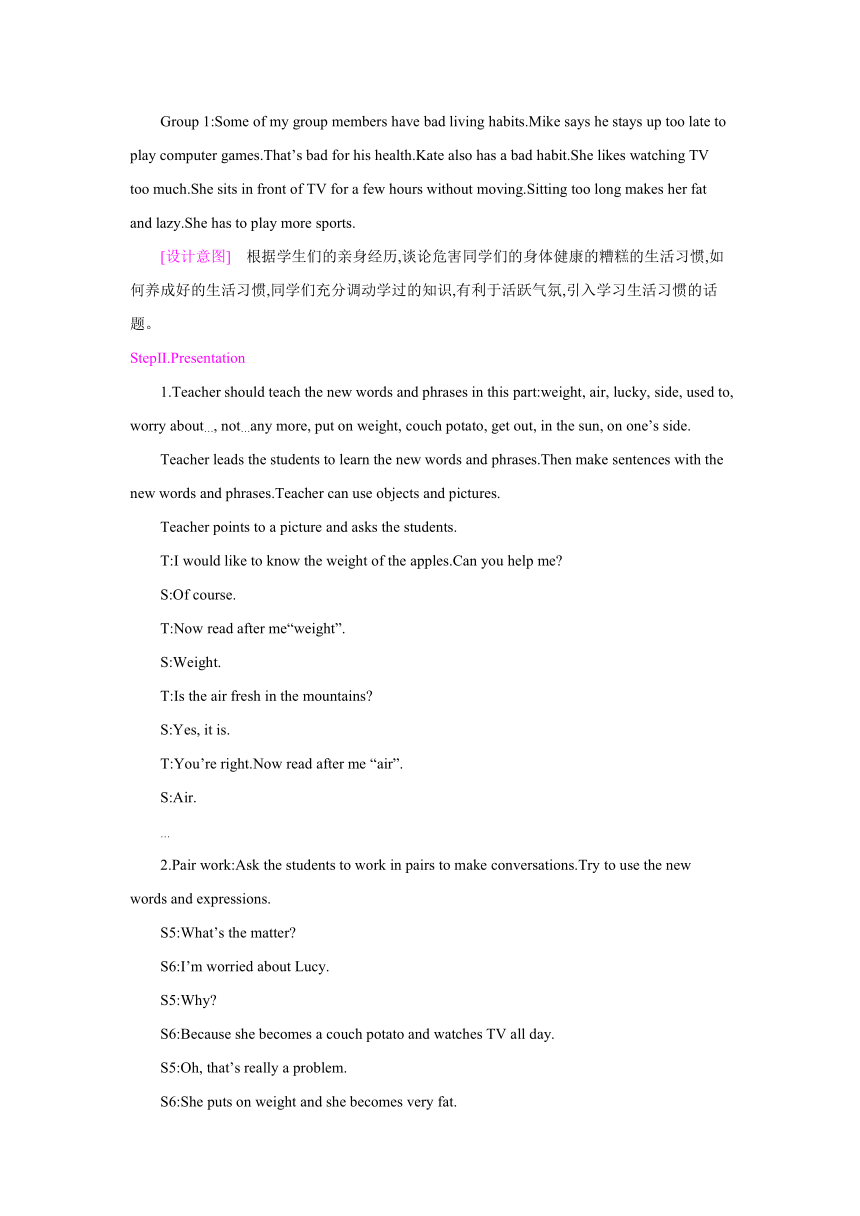
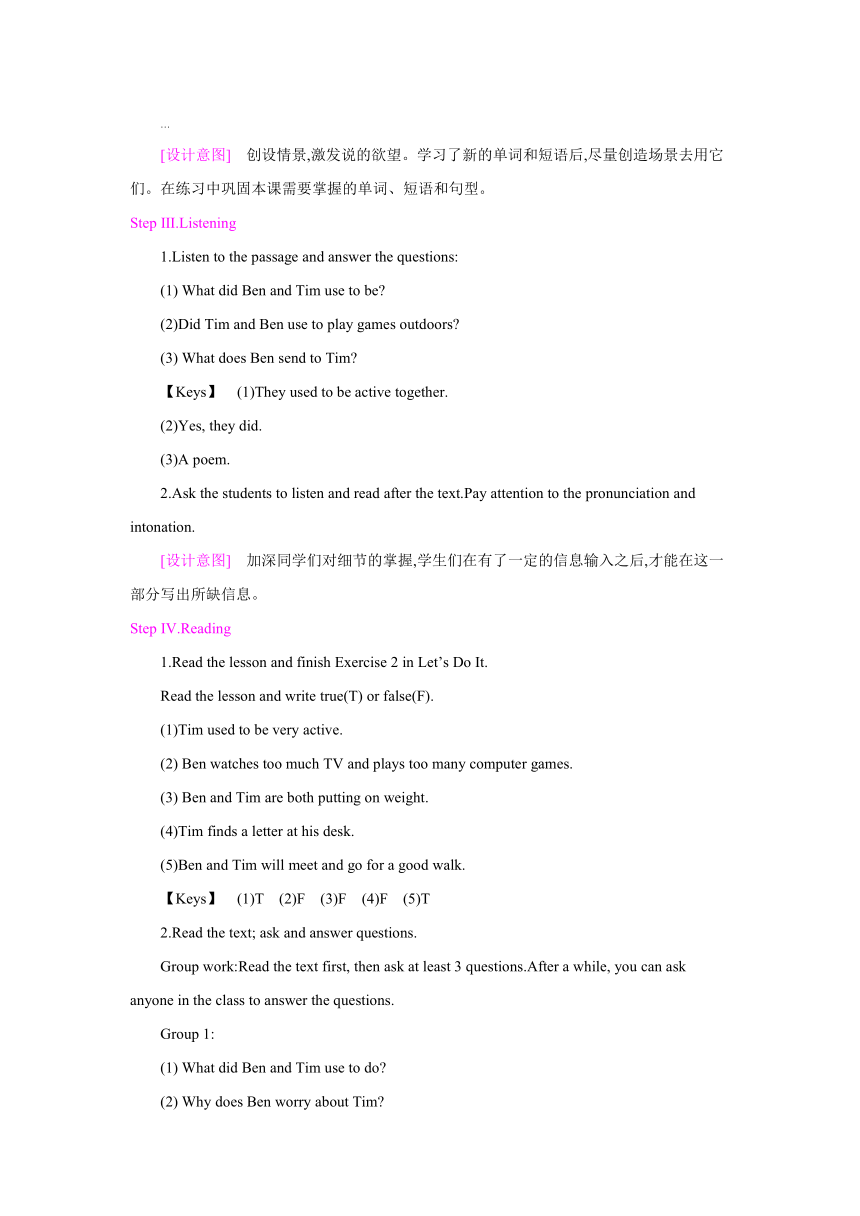
文档简介
Lesson 40 Move Your Body
教学目标:
1.掌握单词:weight, air, lucky, side
短语:used to, worry about…, not…any more, put on weight, couch potato, get out, in the sun, on one’s side, etc.
2.掌握和运用关于生活习惯的句型:
They used to be very active together.
They walked everywhere.
They played games outdoors.
But now Ben worries about Tim.
Tim is not active any more.
He has some bad habits.
He watches too much TV and plays too many computer games.
And he is putting on weight.
Ben sends his friend a poem:
Tim arrives home from school.
There is a letter at his front door.
He reads the poem and he smiles.
He writes a poem back to his friend:
3.能使用There be结构、一般现在时和一般过去时。
4.掌握描述生活习惯的英语。
5.增加同学们学习英语的热情,了解课后学习英语的正确方法。
6.了解西方一些国家的生活习惯。
教学内容:
1.学会运用关于生活习惯的词或短语:weight, air, lucky, side, used to, worry about…, not…any more, put on weight, couch potato, get out, in the sun, on one’s side。
2.学会关于生活习惯的句型:
They used to be very active together.
They walked everywhere.
They played games outdoors.
But now Ben worries about Tim.
Tim is not active any more.
He has some bad habits.
He watches too much TV and plays too many computer games.
And he is putting on weight.
Ben sends his friend a poem:
Tim arrives home from school.
There is a letter at his front door.
He reads the poem and he smiles.
He writes a poem back to his friend:
3.能使用There be结构、一般现在时和一般过去时。
4.掌握描述生活习惯的英语。
5.增加同学们学习英语的热情,了解课后学习英语的正确方法。
6.了解西方一些国家的生活习惯。
重点难点:
1.正确使用本课的词和短语,分辨、会用weight, air, lucky, side, used to, worry about…, not…any more, put on weight, couch potato, get out, in the sun, on one’s side。
2.能使用There be结构、一般现在时和一般过去时。
3.能听懂和了解西方一些国家的生活习惯。
教学思路:
本课时的教学内容是冀教版七年级英语下册第七单元的第四课时,重点在于引导学生理解语境,从“生活习惯”开始,自然地导入用英语描述生活习惯的话题。以如何用英语描述生活习惯作为任务引起学生的听说兴趣,训练学生的听力和口语表达能力。利用实物或图片学习英语单词,同时在对话中反复运用新学的单词和短语。因此,教师可以将知识目标定为掌握本课时新出现的词和短语,用英语描述生活习惯的句型。情感目标定为通过话题的学习,给学生们指出了养成好的生活习惯的意义,用英语描述好的生活习惯应该包括哪些,坏的生活习惯有哪些。通过本课的学习,让同学们了解养成好的生活习惯的重要性。
教学准备:
设计教学PPT,录音机,多媒体,相应的插图,表示一些活动的实物、图片和单词卡片。
教学过程:
StepⅠ.Lead in
Leading in 【情景1】
Show some pictures of what the students are doing.Ask them to talk about the pictures.Point to the pictures.Ask the students questions:
T:What is the boy doing?
S1:He is watching TV.
T:Is watching TV a good habit or a bad habit?
S2:It’s a bad habit.
T:Why?
S3:Because sitting too long makes him fat and lazy.
T:What should he do?
S4:He should do more exercise.
…
[设计意图] 本课内容和生活习惯有关,故以“看图画,说一说”的形式,熟悉本课要学习的内容,发现坏的生活习惯并改正它们,让同学们对号入座,并活跃课堂气氛。同时引入在之后学习中会使用到的词汇、短语和句型。
Leading in 【情景2】
Work in groups.Ask the students to talk about their living habits.
S1:What do you think of your living habits?
S2:I think I have some bad living habits.
S1:What are they?
S2:For example,I often stay up late to play computer games.
S1:Oh, that’s really a bad habit.You have to correct it.What about you, Kate?
S3:I think I have some bad living habits, too.
S1:What are they?
S3:For example,I often watch TV for a few hours without moving.
S1:Oh, it’s bad for your health.
…
After a few minutes, ask the groups to give a speech in front of the class.
Group 1:Some of my group members have bad living habits.Mike says he stays up too late to play computer games.That’s bad for his health.Kate also has a bad habit.She likes watching TV too much.She sits in front of TV for a few hours without moving.Sitting too long makes her fat and lazy.She has to play more sports.
[设计意图] 根据学生们的亲身经历,谈论危害同学们的身体健康的糟糕的生活习惯,如何养成好的生活习惯,同学们充分调动学过的知识,有利于活跃气氛,引入学习生活习惯的话题。
StepⅡ.Presentation
1.Teacher should teach the new words and phrases in this part:weight, air, lucky, side, used to, worry about…, not…any more, put on weight, couch potato, get out, in the sun, on one’s side.
Teacher leads the students to learn the new words and phrases.Then make sentences with the new words and phrases.Teacher can use objects and pictures.
Teacher points to a picture and asks the students.
T:I would like to know the weight of the apples.Can you help me?
S:Of course.
T:Now read after me“weight”.
S:Weight.
T:Is the air fresh in the mountains?
S:Yes, it is.
T:You’re right.Now read after me “air”.
S:Air.
…
2.Pair work:Ask the students to work in pairs to make conversations.Try to use the new words and expressions.
S5:What’s the matter?
S6:I’m worried about Lucy.
S5:Why?
S6:Because she becomes a couch potato and watches TV all day.
S5:Oh, that’s really a problem.
S6:She puts on weight and she becomes very fat.
…
[设计意图] 创设情景,激发说的欲望。学习了新的单词和短语后,尽量创造场景去用它们。在练习中巩固本课需要掌握的单词、短语和句型。
Step Ⅲ.Listening
1.Listen to the passage and answer the questions:
(1) What did Ben and Tim use to be?
(2)Did Tim and Ben use to play games outdoors?
(3) What does Ben send to Tim?
【Keys】 (1)They used to be active together.
(2)Yes, they did.
(3)A poem.
2.Ask the students to listen and read after the text.Pay attention to the pronunciation and intonation.
[设计意图] 加深同学们对细节的掌握,学生们在有了一定的信息输入之后,才能在这一部分写出所缺信息。
Step Ⅳ.Reading
1.Read the lesson and finish Exercise 2 in Let’s Do It.
Read the lesson and write true(T) or false(F).
(1)Tim used to be very active.
(2) Ben watches too much TV and plays too many computer games.
(3) Ben and Tim are both putting on weight.
(4)Tim finds a letter at his desk.
(5)Ben and Tim will meet and go for a good walk.
【Keys】 (1)T (2)F (3)F (4)F (5)T
2.Read the text; ask and answer questions.
Group work:Read the text first, then ask at least 3 questions.After a while, you can ask anyone in the class to answer the questions.
Group 1:
(1) What did Ben and Tim use to do?
(2) Why does Ben worry about Tim?
(3)What are Tim’s bad habits?
(4)Does Tim write a poem back to Ben?
【Keys】 (1)They used to walk everywhere.They played games outdoors.
(2) Because Tim is not active any more.
(3)He watches too much TV and plays too many computer games.
(4)Yes, he does.
3.Poems are a fun way to use language.They often have rhyming words in them.Ben uses four rhyming words in his poem:day—way; fun—sun.Can you find the rhyming words in Tim’s poem?
4.Ask the students to read the text.
T:Now let’s read the text.At the same time, pay attention to the pronunciation and intonation.
Ask some students to read aloud in class.
T:Now let’s see who can read best.
5.Read and find the key points.
The following language points should be explained.
☆教材解读☆
1.They used to be very active together.?
used to do表示过去常常做某事,描述过去经常发生的动作或存在的状态,而现在却不再发生。其中的to是不定式符号,不是介词,所以其后接动词原形(不接动名词)。
He used to live in Paris.
他过去一直住在巴黎。
2.They played games outdoors.?
【辨析】 game, match,sport
(1)game主要指决定胜负的游戏,通常有一套规则,凡参加者均要遵守。
Let’s go and watch the football game.
咱们去看足球赛吧。
(2)match在英国表示 “比赛”,而在美国通常用 game 表示“比赛”。另外,game 作复数时一般指大型的国际体育运动会。
Which country will hold the Olympic Games?哪个国家将会举办奥运会?
(3)sport 多指户外的游戏或娱乐活动,例如:打球、跳高、游泳、钓鱼等。
Skating is one of the winter sports.
滑冰是冬季运动中的一个项目。
3.But now Ben worries about Tim.?
worry about sb./sth.意为“担心某人/某事”。
Don’t worry about me, mum.
妈妈,不要担心我。
【拓展】 worried是worry的形容词,be worried about sb./sth.意为“担心某人/某事”,表示状态。
Parents are always worried about their children.父母总是担心他们的孩子们。
4.He watches too much TV and plays too many computer games.?
【辨析】 too many, too much,much too
(1)too many意为“太多”,接可数名词复数,too对many起修饰作用,重点在many。
He ate too many bananas.
他吃了太多的香蕉。
(2)too much意为“太多”,接不可数名词,too对much起修饰作用,重点在much。
He spends too much money.
他花的钱太多了。
(3)much too意为“太”,接形容词或副词,much对too 起修饰作用,重点在too。
The coat is much too big for me.
这个外套对我来说太大了。
5.And he is putting on weight.?
put on weight意为“增加体重;长胖”。
My sister is putting on weight.
我妹妹在长胖。
【拓展】 weigh用作动词,意为“称……的重量”。
Let’s weigh the baby.
让我们称称这个婴儿的重量。
6.Fresh air, a bike ride,playing in the sun!?
in the sun意为“在阳光下”。sun属于世界上独一无二的事物,所以前面必须加the。
Don’t read in the sun.不要在阳光下读书。
7.But I feel really lucky.?
lucky为形容词,意为“幸运的”。是由名词luck加-y构成的形容词。其反义词为unlucky。
You are lucky.你是幸运的。
【拓展】 (1)luck用作名词(不可数),意为“运气,好运,幸运”。
Good luck!好运!
(2)luckily用作副词,意为“幸运地,幸亏”。
Luckily there was a doctor on the spot.
幸运的是现场有一位医生。
[设计意图] 朗读比赛能激发学生的读书欲望,给学生们提供展示的机会。读书找到关键信息这个任务,能提高同学们的阅读理解能力。
Step Ⅴ.Practice
1.Ask the students to retell the story with their own words.
2.Work in groups.Ask the students to talk about one interesting thing.It happens between friends.
3.Ask the students to make sentences with the new words, expressions and patterns.
[设计意图] “学为所用”,模仿本课内容,谈论你和朋友之间互相帮助的有意义的事情,培养学生运用目标语言进行交际的能力。重述故事考查同学们对课文细节的理解和记忆。
Step Ⅵ.Complete Let’s Do It!
Exercise 1 is listening part.Ask the students to finish it in class.Exercise 2 is reading part.We have finished it in class.Ask the students to finish Exercise 3 by themselves.Check the answers in class.
[设计意图] Let’s Do It!部分中的Exercise 1是听力教学,让同学们在课上完成。Exercise 2是阅读教学,我们在阅读部分已经完成了任务。Exercise 3主要考查同学们对本课短语和句型的熟练程度。
Step Ⅶ.Task
Finish Exercise 4 in groups.
Work in groups.Good friends are important.They help each other.Did a friend ever help you? Did you ever help a friend? What happened?
Talk about it.
[设计意图] Exercise 4提供给同学们一个练习本课单词、短语和句型的机会,给同学们时间练习,给他们展示的机会,这是本课内容的升华。
Step Ⅷ.Exercises
Fill in the blanks.
1.他们过去在一起常常很活跃。
They very active together.?
2.现在本为蒂姆担心。
Now Ben Tim.?
3.让我们在阳光下玩耍。
Let’s play .?
4.让我们晚饭后出去好好散步吧。
Let’s for a good after supper.?
5.我妹妹整天看电视。
My sister watches TV .?
【Keys】 1.used to be 2.worries about 3.in the sun 4.go out, walk 5.all day
[设计意图] 以学评教、强化落实。当堂检测主要是由本节内容组成的形成性评价,检测当堂学习效果。
Step Ⅸ.Homework
1.Learn the new words and expressions by heart.
2.Prepare for the next lesson.
[设计意图] “学为所用”,课上学习的知识,要在课下充分练习才能真正掌握。
Lesson 40 Move Your Body
weight, air, lucky, side, used to,worry about…, not…any more,
put on weight, couch potato, get out,
in the sun, on one’s side
They used to be very active together.
They walked everywhere.
They played games outdoors.
But now Ben worries about Tim.
Tim is not active any more.
He has some bad habits.
And he is putting on weight.
Ben sends his friend a poem:
Tim arrives home from school.
There is a letter at his front door.
He reads the poem and he smiles.
He writes a poem back to his friend:
He watches too much TV and plays too many computer games.
教材习题解答
【Keys】 1 1-3-2-5-4
3 1.used to 2.worry about 3.putting on weight 4.any more 5.go for a walk
教学目标:
1.掌握单词:weight, air, lucky, side
短语:used to, worry about…, not…any more, put on weight, couch potato, get out, in the sun, on one’s side, etc.
2.掌握和运用关于生活习惯的句型:
They used to be very active together.
They walked everywhere.
They played games outdoors.
But now Ben worries about Tim.
Tim is not active any more.
He has some bad habits.
He watches too much TV and plays too many computer games.
And he is putting on weight.
Ben sends his friend a poem:
Tim arrives home from school.
There is a letter at his front door.
He reads the poem and he smiles.
He writes a poem back to his friend:
3.能使用There be结构、一般现在时和一般过去时。
4.掌握描述生活习惯的英语。
5.增加同学们学习英语的热情,了解课后学习英语的正确方法。
6.了解西方一些国家的生活习惯。
教学内容:
1.学会运用关于生活习惯的词或短语:weight, air, lucky, side, used to, worry about…, not…any more, put on weight, couch potato, get out, in the sun, on one’s side。
2.学会关于生活习惯的句型:
They used to be very active together.
They walked everywhere.
They played games outdoors.
But now Ben worries about Tim.
Tim is not active any more.
He has some bad habits.
He watches too much TV and plays too many computer games.
And he is putting on weight.
Ben sends his friend a poem:
Tim arrives home from school.
There is a letter at his front door.
He reads the poem and he smiles.
He writes a poem back to his friend:
3.能使用There be结构、一般现在时和一般过去时。
4.掌握描述生活习惯的英语。
5.增加同学们学习英语的热情,了解课后学习英语的正确方法。
6.了解西方一些国家的生活习惯。
重点难点:
1.正确使用本课的词和短语,分辨、会用weight, air, lucky, side, used to, worry about…, not…any more, put on weight, couch potato, get out, in the sun, on one’s side。
2.能使用There be结构、一般现在时和一般过去时。
3.能听懂和了解西方一些国家的生活习惯。
教学思路:
本课时的教学内容是冀教版七年级英语下册第七单元的第四课时,重点在于引导学生理解语境,从“生活习惯”开始,自然地导入用英语描述生活习惯的话题。以如何用英语描述生活习惯作为任务引起学生的听说兴趣,训练学生的听力和口语表达能力。利用实物或图片学习英语单词,同时在对话中反复运用新学的单词和短语。因此,教师可以将知识目标定为掌握本课时新出现的词和短语,用英语描述生活习惯的句型。情感目标定为通过话题的学习,给学生们指出了养成好的生活习惯的意义,用英语描述好的生活习惯应该包括哪些,坏的生活习惯有哪些。通过本课的学习,让同学们了解养成好的生活习惯的重要性。
教学准备:
设计教学PPT,录音机,多媒体,相应的插图,表示一些活动的实物、图片和单词卡片。
教学过程:
StepⅠ.Lead in
Leading in 【情景1】
Show some pictures of what the students are doing.Ask them to talk about the pictures.Point to the pictures.Ask the students questions:
T:What is the boy doing?
S1:He is watching TV.
T:Is watching TV a good habit or a bad habit?
S2:It’s a bad habit.
T:Why?
S3:Because sitting too long makes him fat and lazy.
T:What should he do?
S4:He should do more exercise.
…
[设计意图] 本课内容和生活习惯有关,故以“看图画,说一说”的形式,熟悉本课要学习的内容,发现坏的生活习惯并改正它们,让同学们对号入座,并活跃课堂气氛。同时引入在之后学习中会使用到的词汇、短语和句型。
Leading in 【情景2】
Work in groups.Ask the students to talk about their living habits.
S1:What do you think of your living habits?
S2:I think I have some bad living habits.
S1:What are they?
S2:For example,I often stay up late to play computer games.
S1:Oh, that’s really a bad habit.You have to correct it.What about you, Kate?
S3:I think I have some bad living habits, too.
S1:What are they?
S3:For example,I often watch TV for a few hours without moving.
S1:Oh, it’s bad for your health.
…
After a few minutes, ask the groups to give a speech in front of the class.
Group 1:Some of my group members have bad living habits.Mike says he stays up too late to play computer games.That’s bad for his health.Kate also has a bad habit.She likes watching TV too much.She sits in front of TV for a few hours without moving.Sitting too long makes her fat and lazy.She has to play more sports.
[设计意图] 根据学生们的亲身经历,谈论危害同学们的身体健康的糟糕的生活习惯,如何养成好的生活习惯,同学们充分调动学过的知识,有利于活跃气氛,引入学习生活习惯的话题。
StepⅡ.Presentation
1.Teacher should teach the new words and phrases in this part:weight, air, lucky, side, used to, worry about…, not…any more, put on weight, couch potato, get out, in the sun, on one’s side.
Teacher leads the students to learn the new words and phrases.Then make sentences with the new words and phrases.Teacher can use objects and pictures.
Teacher points to a picture and asks the students.
T:I would like to know the weight of the apples.Can you help me?
S:Of course.
T:Now read after me“weight”.
S:Weight.
T:Is the air fresh in the mountains?
S:Yes, it is.
T:You’re right.Now read after me “air”.
S:Air.
…
2.Pair work:Ask the students to work in pairs to make conversations.Try to use the new words and expressions.
S5:What’s the matter?
S6:I’m worried about Lucy.
S5:Why?
S6:Because she becomes a couch potato and watches TV all day.
S5:Oh, that’s really a problem.
S6:She puts on weight and she becomes very fat.
…
[设计意图] 创设情景,激发说的欲望。学习了新的单词和短语后,尽量创造场景去用它们。在练习中巩固本课需要掌握的单词、短语和句型。
Step Ⅲ.Listening
1.Listen to the passage and answer the questions:
(1) What did Ben and Tim use to be?
(2)Did Tim and Ben use to play games outdoors?
(3) What does Ben send to Tim?
【Keys】 (1)They used to be active together.
(2)Yes, they did.
(3)A poem.
2.Ask the students to listen and read after the text.Pay attention to the pronunciation and intonation.
[设计意图] 加深同学们对细节的掌握,学生们在有了一定的信息输入之后,才能在这一部分写出所缺信息。
Step Ⅳ.Reading
1.Read the lesson and finish Exercise 2 in Let’s Do It.
Read the lesson and write true(T) or false(F).
(1)Tim used to be very active.
(2) Ben watches too much TV and plays too many computer games.
(3) Ben and Tim are both putting on weight.
(4)Tim finds a letter at his desk.
(5)Ben and Tim will meet and go for a good walk.
【Keys】 (1)T (2)F (3)F (4)F (5)T
2.Read the text; ask and answer questions.
Group work:Read the text first, then ask at least 3 questions.After a while, you can ask anyone in the class to answer the questions.
Group 1:
(1) What did Ben and Tim use to do?
(2) Why does Ben worry about Tim?
(3)What are Tim’s bad habits?
(4)Does Tim write a poem back to Ben?
【Keys】 (1)They used to walk everywhere.They played games outdoors.
(2) Because Tim is not active any more.
(3)He watches too much TV and plays too many computer games.
(4)Yes, he does.
3.Poems are a fun way to use language.They often have rhyming words in them.Ben uses four rhyming words in his poem:day—way; fun—sun.Can you find the rhyming words in Tim’s poem?
4.Ask the students to read the text.
T:Now let’s read the text.At the same time, pay attention to the pronunciation and intonation.
Ask some students to read aloud in class.
T:Now let’s see who can read best.
5.Read and find the key points.
The following language points should be explained.
☆教材解读☆
1.They used to be very active together.?
used to do表示过去常常做某事,描述过去经常发生的动作或存在的状态,而现在却不再发生。其中的to是不定式符号,不是介词,所以其后接动词原形(不接动名词)。
He used to live in Paris.
他过去一直住在巴黎。
2.They played games outdoors.?
【辨析】 game, match,sport
(1)game主要指决定胜负的游戏,通常有一套规则,凡参加者均要遵守。
Let’s go and watch the football game.
咱们去看足球赛吧。
(2)match在英国表示 “比赛”,而在美国通常用 game 表示“比赛”。另外,game 作复数时一般指大型的国际体育运动会。
Which country will hold the Olympic Games?哪个国家将会举办奥运会?
(3)sport 多指户外的游戏或娱乐活动,例如:打球、跳高、游泳、钓鱼等。
Skating is one of the winter sports.
滑冰是冬季运动中的一个项目。
3.But now Ben worries about Tim.?
worry about sb./sth.意为“担心某人/某事”。
Don’t worry about me, mum.
妈妈,不要担心我。
【拓展】 worried是worry的形容词,be worried about sb./sth.意为“担心某人/某事”,表示状态。
Parents are always worried about their children.父母总是担心他们的孩子们。
4.He watches too much TV and plays too many computer games.?
【辨析】 too many, too much,much too
(1)too many意为“太多”,接可数名词复数,too对many起修饰作用,重点在many。
He ate too many bananas.
他吃了太多的香蕉。
(2)too much意为“太多”,接不可数名词,too对much起修饰作用,重点在much。
He spends too much money.
他花的钱太多了。
(3)much too意为“太”,接形容词或副词,much对too 起修饰作用,重点在too。
The coat is much too big for me.
这个外套对我来说太大了。
5.And he is putting on weight.?
put on weight意为“增加体重;长胖”。
My sister is putting on weight.
我妹妹在长胖。
【拓展】 weigh用作动词,意为“称……的重量”。
Let’s weigh the baby.
让我们称称这个婴儿的重量。
6.Fresh air, a bike ride,playing in the sun!?
in the sun意为“在阳光下”。sun属于世界上独一无二的事物,所以前面必须加the。
Don’t read in the sun.不要在阳光下读书。
7.But I feel really lucky.?
lucky为形容词,意为“幸运的”。是由名词luck加-y构成的形容词。其反义词为unlucky。
You are lucky.你是幸运的。
【拓展】 (1)luck用作名词(不可数),意为“运气,好运,幸运”。
Good luck!好运!
(2)luckily用作副词,意为“幸运地,幸亏”。
Luckily there was a doctor on the spot.
幸运的是现场有一位医生。
[设计意图] 朗读比赛能激发学生的读书欲望,给学生们提供展示的机会。读书找到关键信息这个任务,能提高同学们的阅读理解能力。
Step Ⅴ.Practice
1.Ask the students to retell the story with their own words.
2.Work in groups.Ask the students to talk about one interesting thing.It happens between friends.
3.Ask the students to make sentences with the new words, expressions and patterns.
[设计意图] “学为所用”,模仿本课内容,谈论你和朋友之间互相帮助的有意义的事情,培养学生运用目标语言进行交际的能力。重述故事考查同学们对课文细节的理解和记忆。
Step Ⅵ.Complete Let’s Do It!
Exercise 1 is listening part.Ask the students to finish it in class.Exercise 2 is reading part.We have finished it in class.Ask the students to finish Exercise 3 by themselves.Check the answers in class.
[设计意图] Let’s Do It!部分中的Exercise 1是听力教学,让同学们在课上完成。Exercise 2是阅读教学,我们在阅读部分已经完成了任务。Exercise 3主要考查同学们对本课短语和句型的熟练程度。
Step Ⅶ.Task
Finish Exercise 4 in groups.
Work in groups.Good friends are important.They help each other.Did a friend ever help you? Did you ever help a friend? What happened?
Talk about it.
[设计意图] Exercise 4提供给同学们一个练习本课单词、短语和句型的机会,给同学们时间练习,给他们展示的机会,这是本课内容的升华。
Step Ⅷ.Exercises
Fill in the blanks.
1.他们过去在一起常常很活跃。
They very active together.?
2.现在本为蒂姆担心。
Now Ben Tim.?
3.让我们在阳光下玩耍。
Let’s play .?
4.让我们晚饭后出去好好散步吧。
Let’s for a good after supper.?
5.我妹妹整天看电视。
My sister watches TV .?
【Keys】 1.used to be 2.worries about 3.in the sun 4.go out, walk 5.all day
[设计意图] 以学评教、强化落实。当堂检测主要是由本节内容组成的形成性评价,检测当堂学习效果。
Step Ⅸ.Homework
1.Learn the new words and expressions by heart.
2.Prepare for the next lesson.
[设计意图] “学为所用”,课上学习的知识,要在课下充分练习才能真正掌握。
Lesson 40 Move Your Body
weight, air, lucky, side, used to,worry about…, not…any more,
put on weight, couch potato, get out,
in the sun, on one’s side
They used to be very active together.
They walked everywhere.
They played games outdoors.
But now Ben worries about Tim.
Tim is not active any more.
He has some bad habits.
And he is putting on weight.
Ben sends his friend a poem:
Tim arrives home from school.
There is a letter at his front door.
He reads the poem and he smiles.
He writes a poem back to his friend:
He watches too much TV and plays too many computer games.
教材习题解答
【Keys】 1 1-3-2-5-4
3 1.used to 2.worry about 3.putting on weight 4.any more 5.go for a walk
同课章节目录
- Unit 1 A Trip to the Silk Road
- Lesson 1 A Trip to China
- Lesson 2 Meet You in Beijing
- Lesson 3 A Visit to Xi'an
- Lesson 4 A Visit to Lanzhou
- Lesson 5 Another Stop along the Silk Road
- Lesson 6 Jenny's Diary
- Unit 2 It's Show Time!
- Lesson 7 What's Your Project about?
- Lesson 8 Marco Polo and the Silk Road
- Lesson 9 Danny's School Project
- Lesson 10 Music and Dance
- Lesson 11 Food in China
- Lesson 12 A Blog about the Silk Road
- Unit 3 School Life
- Lesson 13 How Is School Going?
- Lesson 14 Jenny's School Life
- Lesson 15 Making a Difference
- Lesson 16 We Are with You!
- Lesson 17 School Science Fai
- Lesson 18 Teaching in China
- Unit 4 After-School Activities
- Lesson 19 A Dinner Date
- Lesson 20 Join Our Club!
- Lesson 21 What Is Your Club Type?
- Lesson 22 Big Plans for the Weekend
- Lesson 23 A Weekend with Grandma
- Lesson 24 How was Your Weekend?
- Unit 5 I Love Learning English!
- Lesson 25 A Phone Friend
- Lesson 26 Online Phone Calls
- Lesson 27 Amazing English
- Lesson 28 How Do I Learn English?
- Lesson 29 A Door to the World
- Lesson 30 Writing an E-mail in English
- Unit 6 Seasons
- Lesson 31 What Strange Weather!
- Lesson 32 I Can't Wait for Winter!
- Lesson 33 Kim's Favourite Season
- Lesson 34 Steven's Report
- Lesson 35 Surfing in Sydney
- Lesson 36 Spring in China
- Unit 7 Sports and Good Health
- Lesson 37 You Are What You Eat!
- Lesson 38 Stay Healthy!
- Lesson 39 Danny's Report
- Lesson 40 Move Your Body
- Lesson 41 Were People Healthy Then?
- Lesson 42 Know Yourself
- Unit 8 Summer Holiday Is Coming!
- Lesson 43 Have a Good Summer!
- Lesson 44 Volunteering in Summe
- Lesson 45 Baseball Season
- Lesson 46 Get Ready for Summer Holiday!
- Lesson 47 Summer Plans
- Lesson 48 Li Ming's Summer Holiday
